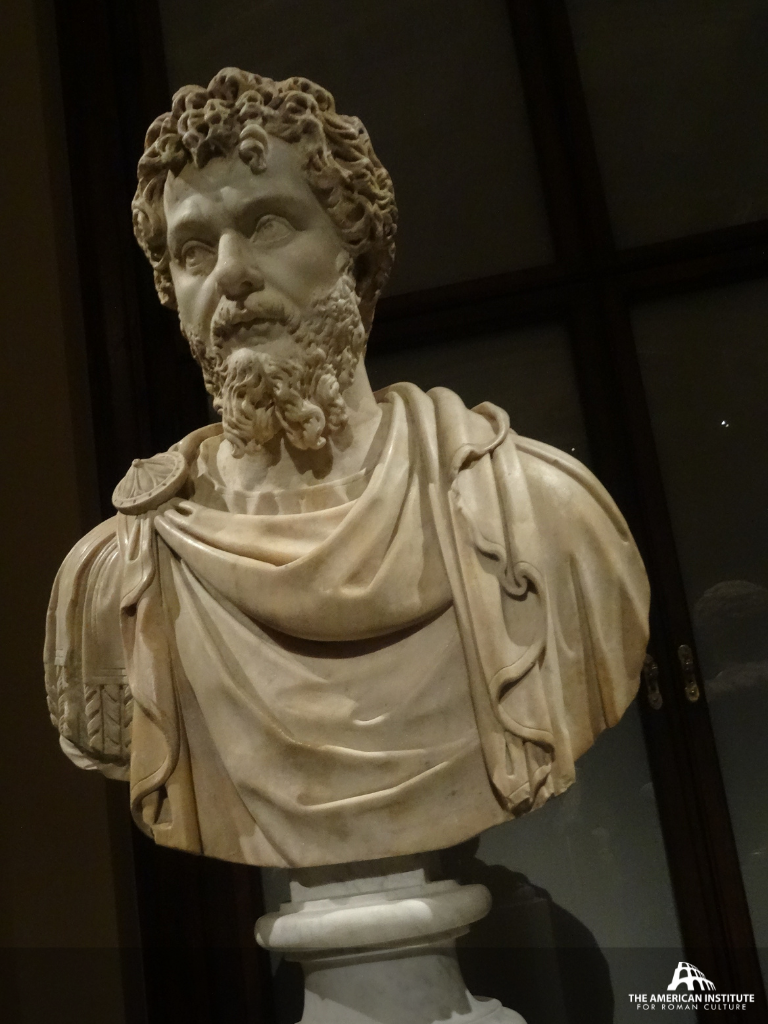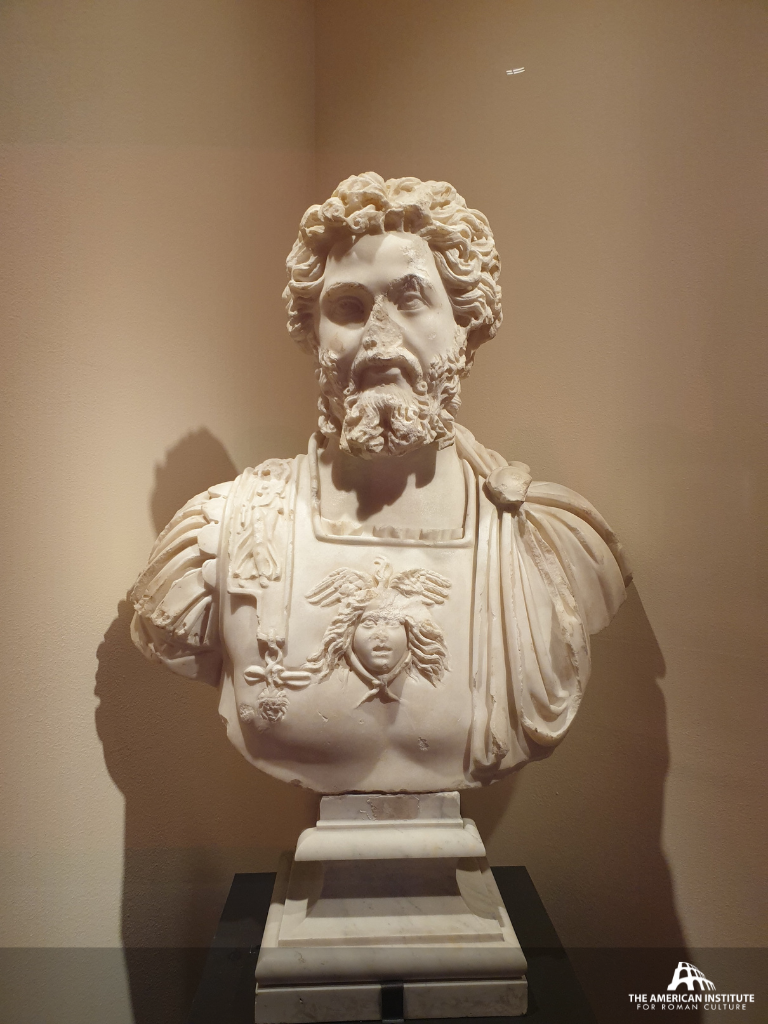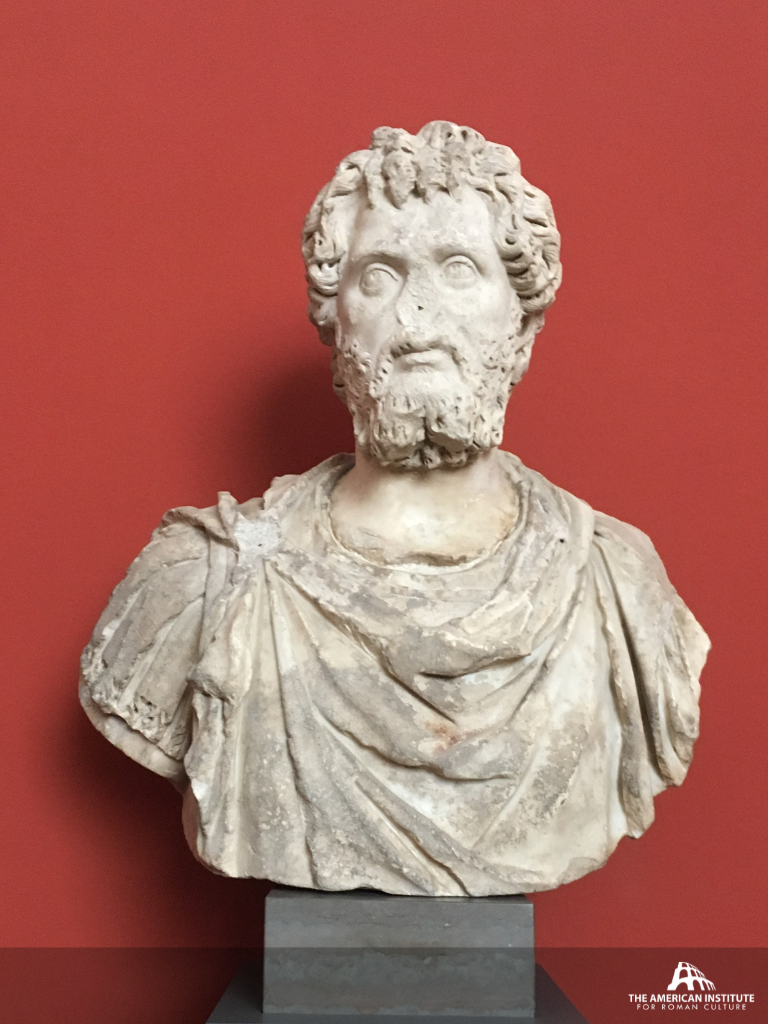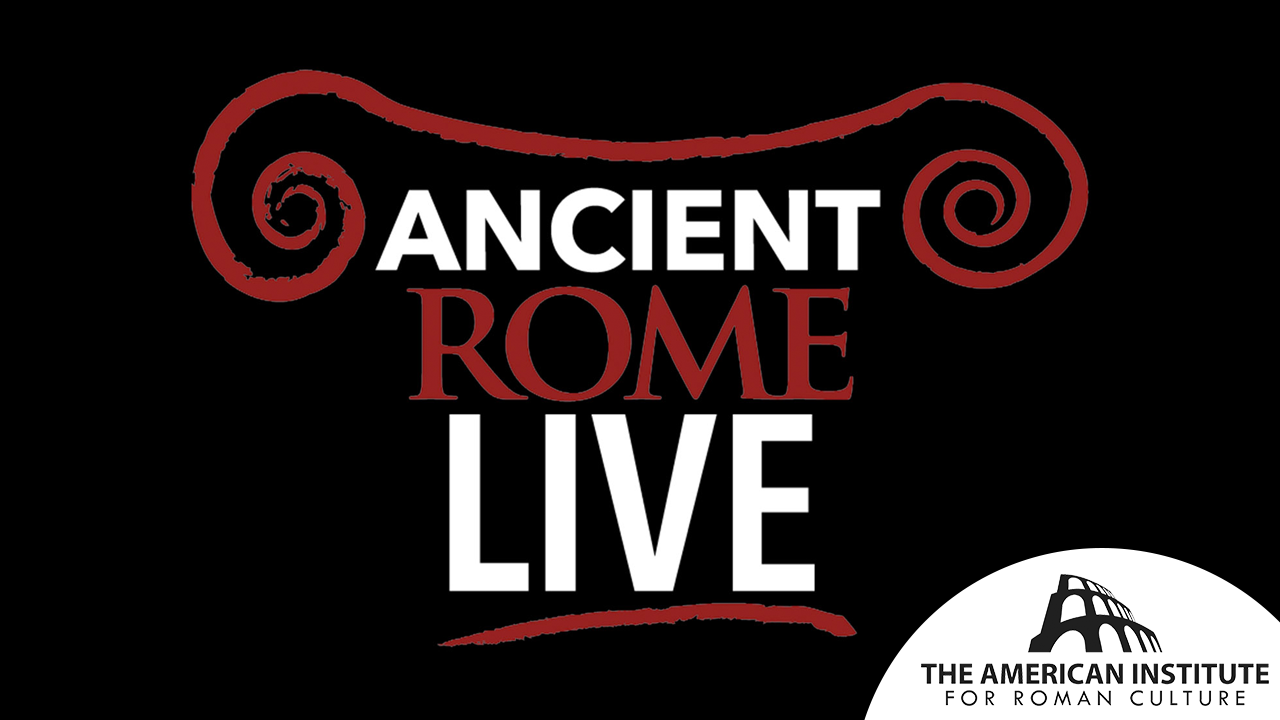Official Name: IMPERATOR CAESAR LUCIUS SEPTIMIUS SEVERUS PERTINAX AUGUSTUS
Birthdate: April 11, 145 CE.
(Historia Augusta, Life of Septimius Severus, 1)
Birthplace: Leptis Magna, Libya.
(Historia Augusta, Life of Septimius Severus, 1)
Reign: Declared emperor by his troops in Carnuntum (city in modern-day Austria) in April 193 CE.
(Herodian 2.10) (Historia Augusta, Life of Septimius Severus, 5)
Marriages:
Paccia Marciana (175-186 CE)
(Historia Augusta, Life of Septimius Severus, 3)
Julia Domna (187-211 CE)
(Historia Augusta, Life of Septimius Severus, 3)
While she was living in Emesa, Syria, an astrologer predicted that Julia Domna would marry a king. After hearing this prophecy, Septimius Severus sought her out and they married in 187 CE. Their marriage was a happy one, lasting over twenty years. During his life, Septimius Severus gave Julia Domna several prestigious titles such as Augusta, Mater Augustus (Mother of Augustus), and Mater Castrorum (Mother of the Camp).
(Historia Augusta, Life of Septimius Severus, 3)
(RIC IV Septimius Severus 161B)
Children:
Death: Septimius Severus died of natural causes in Eboracum (modern-day York, England). He died on February 4, 211 CE.
(Cassius Dio, Roman History, 77.15) (Historia Augusta, Life of Septimius Severus, 18)

Bust of Septimius Severus, Kunsthistorisches Museum, Vienna, October 2019

Bust of Septimius Severus, Roma Universalis Exhibition, Rome, February 2019

Bust of Septimius Severus, NY Carlsberg Glyptothek, Copenhagen, September 2018
Septimius Severus was emperor of Rome from 193-211 CE and the founder of the Severan Dynasty. This dynasty ushered in a period of stability following a civil war known as the Year of the Five Emperors, and it would last over forty years, ending in 235 CE with the assassination of emperor Severus Alexander.
Septimius Severus was born in 145 CE in the wealthy port city of Leptis Magna in modern-day Libya, making him the first emperor from the African continent. By the year 192 CE, Severus had been inducted into the Roman Senate and commanded legions on the Danube frontier. At the end of this year, the reigning emperor Commodus was assassinated, ending the prosperous Antonine Dynasty and the Roman golden age known as the Pax Romana. Rome was thus thrust into a civil war known as the Year of the Five Emperors (193 CE). After the first two self-proclaimed emperors were assassinated in the first half of the year, Septimius Severus was declared emperor by his troops. He marched on Rome in June and won the Senate’s approval by force. Having gained legitimacy for his reign, Severus turned his attention to his two remaining rivals. By the end of the year, he had defeated them both, ending the civil war and restoring order to the empire. Severus followed up his victory with additional military campaigns. In 197 CE, he defeated his old rival Clodius Albinus and also sacked the city of Ctesiphon, the capital of the Parthian Empire. Septimius Severus returned to Rome in 203 CE and ruled directly over the city until 208 CE, when he left to campaign in Britain. In 211 CE, he died of natural causes in Eboracum (modern-day York, England).
The women of the Severan Dynasty also played an important role in maintaining order and stability. The first woman of note is the empress Julia Domna, the wife of Severus. As the daughter of a Syrian high priest, she had strong political ties to the Near East. Her political connections, along with intelligence and insight, helped guide the political decisions of her sons Caracalla and Geta, who would succeed Severus as emperor. Julia Domna was also a patron of the arts, and helped restore the Temple of Vesta after it had been destroyed in a fire. Unfortunately, Julia Domna was unable to ease the enmity that existed between her two sons. In 211 CE, Caracalla murdered his younger brother Geta and damned his memory. When Caracalla was assassinated in 217 CE, Julia Domna took her own life. Her sister, Julia Maesa, succeeded her as imperial matriarch. She rallied the Syrian legions to defeat the usurper Macrinus and placed her grandson Elagabalus on the throne. However, neither Elagabalus nor his successor Severus Alexander, would achieve the same level of glory and military success as Septimius Severus. When Severus Alexander was assassinated by his own troops in 235 CE, the Severan Dynasty officially came to an end.
The Severan Dynasty was responsible for constructing much of what can be seen today in the ruins of Ancient Rome. This includes the Arch of Septimius Severus, which celebrates his victory over the Parthians, and stands in the Roman Forum. On the Palatine Hill, Severus constructed the Septizodium, a monumental fountain that served as the terminus of the Via Appia. He also added an extension to the imperial palace known as the Domus Severiana. The most influential piece of Severan architecture was the Baths of Caracalla. Completed by Severus’ son and successor, the design of this structure is one of the few in the world that can accommodate such a massive interior space. As a result, its design has been replicated in basilicas and train stations across the globe, the most famous example being the original Pennsylvania Station in New York City.
It was the Severans who transformed Rome into a truly international city. Many of Severus’ top lieutenants were fellow North Africans, and it was during his reign that wealthy, provincial areas of the empire gained power and influence. This solidified an overarching Roman identity across the various ethnic groups that made up the empire. However, despite the order and stability that he brought, Severus used his position as emperor to fill his personal coffers and enrich his soldiers. This set a dangerous precedent, and it led to the avarice and tyranny that would come to define Rome and its emperors during the Crisis of the Third Century.
Bibliography
- Arya, Darius. “Julia Domna.” Ancient Rome Live. Last modified 3/29/2022. https://ancientromelive.org/juliadomna/
- Berick, Julia. “A Monument to Impermanence: The Death and Life of New York’s Penn Station.” Tenement Museum. https://www.tenement.org/blog/a-monument-to-impermanence-the-death-and-life-of-new-yorks-penn-station/
- Cartwright, Mark. “The Arch of Septimius Severus, Rome.” World History Encyclopedia, 31 Mar. 2024, www.worldhistory.org/article/502/the-arch-of-septimius-severus-rome/
- Lusnia, S. S. (2004). Urban Planning and Sculptural Display in Severan Rome: Reconstructing the Septizodium and Its Role in Dynastic Politics. American Journal of Archaeology, 108(4), 517–544. http://www.jstor.org/stable/40025729
193
(Historia Augusta, Life of Septimius Severus, 5-10)
197
(Historia Augusta, Life of Septimius Severus, 16)
208
(Herodian 3.14) (Cassius Dio, Roman History, 77.15) (Historia Augusta, Life of Septimius Severus, 18)
211
(Cassius Dio, Roman History, Book 77.15)
This content is brought to you by The American Institute for Roman Culture, a 501(C)3 US Non-Profit Organization.
Please support our mission to aid learning and understanding of ancient Rome through free-to-access content by donating today.
Cite This Page
Cite this page as: Darius Arya, The American Institute for Roman Culture, “Septimius Severus,” Ancient Rome Live. Last modified 1/6/2023. https://ancientromelive.org/SeptimiusSeverus/
License
Created by The American Institute of Roman Culture, published on 1/6/2023 under the following license: Creative Commons: Attribution-NonCommercial-ShareAlike. This license lets others remix, tweak, and build upon this content non-commercially, as long as they credit the author and license their new creations under the identical terms. Please note that content linked from this page may have different licensing terms.



